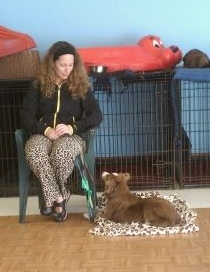Impulse Control for Everyone

In dog training there is a lot of talk about impulse control. I believe it’s such a big issue because most dog owners seek help when their dogs become adolescents, which is also the time when impulse control is at its lowest. This is even more the case with an adolescent who has had no practice in puppyhood. If you work with shelter dogs, I’ve just described the back-story of most relinquished or stray dogs.
Teaching longer sits and downs, introducing stays and leave its, are all part of developing impulse control in dogs. Working on loose leash walking and eye contact are also helpful. Basically, anything that encourages and rewards the dog to put aside what he’d like to do (pull toward something, look at something other than you, move toward you when you walk away, bolt through a door) and instead do some silly (to the dog) thing you’ve asked him to do.
To do any of this effectively, however, the human component in training must also develop some impulse control. I find training human impulse control to be much more difficult. Let’s take something as simple as teaching leave it. You show the dog the treat, close your fist around the treat and wait. That’s it. You wait until the dog is finished licking, gnawing and pawing. When the dog stops trying to get it and moves his nose/mouth away from your hand, you open your hand and say, “Take it!”
I find that even the most untrained, unruly and over-aroused dogs start to get this exercise within three trials. That is, if you can get the human to stop talking and to hold their hand still. Those two things are nearly impossible impulses for some humans to control.
In fact, holding still and being quiet in the presence of a dog under any circumstances seems to be an insurmountable exercise for the average dog lover. There seems to be an overwhelming impulse to verbally negotiate, narrate what we think the dog is thinking and/or to respond to physical contact with reciprocal physical contact.
I think this comes mostly from two different sources. One is a lack of understanding of dog communication. What seems like an uncomfortable silent pause or a burst of meaningless movement to the novice is actually a full, sometimes loud, conversation to those who can “hear” it. It’s easier to be quiet when you understand that the dog is talking right now, albeit with his body instead of his voice. To be honest, I sometimes feel that people are being rude as they continually interrupt what the dog is saying by talking over them and completely ignoring the other half of the conversation. I have to remind myself that they simply haven’t learned the language yet. They don’t realize that it’s a two way conversation.
The second thing I see is a sort of anxious, insecure state of self-consciousness that often comes with learning something new. Some people just can’t shut up when they’re feeling nervous. The simplest of instructions are confounding. As an instructor, I have to remember to break it down into teeny, tiny steps and allow for some chatter as the information sinks in. It’s always easy to remember that with dogs, but I sometimes forget with humans.
I also have to remember that I don’t expect a dog to do a perfect leave it on the first trial. I suppose I can’t expect that of a human either. I can go on and on about how easy teaching a leave it is, but I’m really talking about how easy it is for me because I’ve done it thousands of times with hundreds of dogs. I’ve seen the process work. I know what to expect. I know how to modify the plan depending on the type of response I get from the dog.
Meanwhile, my human student is feeling awkward about not doing or saying anything when the dog is pawing their hand, wondering if they look stupid, trying to remember what comes next, worrying that they won’t recognize the right moment to give the treat and desperately wanting to verbally explain to the dog what they should do.
Ah! So now I am in the position to control my own impulses. While I would love to simply snatch the treat from the student and show them again how it’s done; I have to allow them the time to figure it out for themselves. I have to give them reminders (instructive reprimands) and let them know the second they are doing something right. I have to give them the time to find their way to the big reward at the end…a dog who sits back and looks at them, waiting for the words, “Take it!” That’s when we all get rewarded for controlling our impulses.




